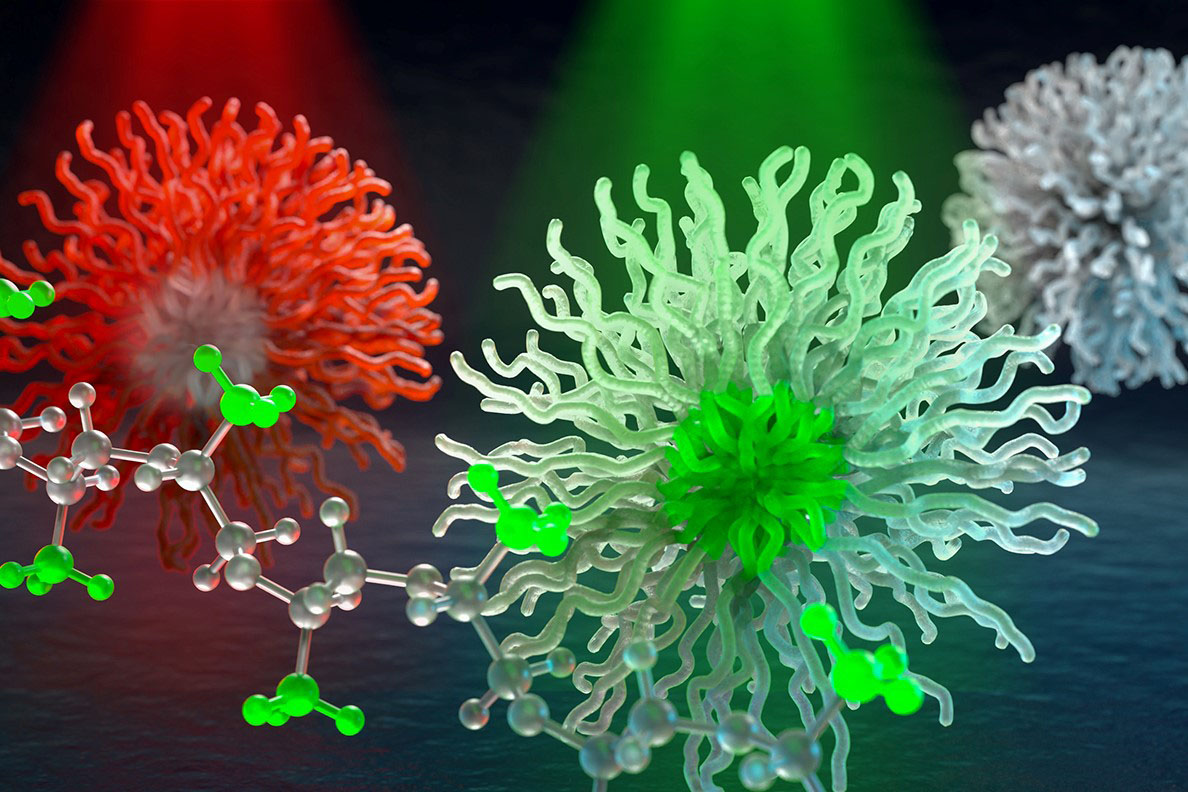SCIENTIFIC ACHIEVEMENT
A technique developed at the Advanced Light Source (ALS) enables accurate characterization of organic nanocarriers (molecules that encapsulate other molecules) without the need for disruptive labeling.
SIGNIFICANCE AND IMPACT
The method will enable faster, more precise development of exciting new technologies, ranging from targeted drug delivery to oil-spill remediation.

Molecular packaging
Micelles are self-assembling nanostructures made up of both water-averse (hydrophobic) and water-loving (hydrophilic) polymer chains. In water, the hydrophobic parts bunch together and become surrounded by the hydrophilic parts, which form a shell that can encapsulate other “guest” molecules. This ability to form neat molecular packages makes micelles attractive for the delivery of vaccines or targeted cancer therapies. A single-polymer form of micelle known as a “polysoap” could also be used for the sequestration and remediation of oil spills in water.
The performance of these micelle nanocarriers depends on characteristics such as size, shape, and composition. And because they self-assemble in response to their surroundings, improvements in their design and function require studies performed in aqueous environments. However, most such investigations have involved labeling methods that can distort structure and disrupt behavior, especially for carbon-based materials. Now, a new technique developed at the ALS allows researchers to analyze nanocarriers in a fully natural state, immersed in water and without disruptive labels.
Label-free bond contrast

The first type of micelle analyzed using the new technique consisted of an aggregation of triblock copolymers—i.e., polymers with one hydrophobic block (polypropylene oxide, or PPO) flanked by two hydrophilic blocks (polyethylene oxide, or PEO). At Berkeley Lab’s Molecular Foundry, transmission electron microscopy (TEM) revealed that the micelles expand in water and shrink when dry. However, TEM does not distinguish between the similar electron densities of the two polymer blocks.
Resonant soft x-ray scattering (RSoXS) at ALS Beamline 11.0.1.2 solves this issue by tuning incident x-rays to resonate with a particular chemical bond—in this case, with the carbon in a methyl group (CH3) that occurs only in the PPO. A liquid flow and mixing cell, based on the TEM apparatus but customized for use in the beamline, allows rapid, direct, dynamic measurements of structure and behavior under changing solution conditions.
Analysis of the features in the x-ray scattering profiles allowed the researchers to characterize nanocarrier substructure and chemical composition. The results indicated a pure PPO core (less than 5% water) and a hydrated (91% water) PEO shell. The extreme shell hydration explains why these materials are biocompatible and stable under biological conditions.
Bunches of polysoap “flowers”
The researchers next studied polysoap nanocarriers—single-molecule micelles developed at the University of Southern Mississippi for the remediation of oil spills. In dilute quantities, the polymer self-assembles into flower-like shapes, with hydrophobic centers and hydrophilic “petals.” The idea is that oil molecules would be sequestered in the centers, facilitating remediation.
An unresolved question was whether, at higher concentrations, the single-chain (unimeric) cores would coalesce into multimers, drastically reducing the surface area available for hydrocarbon capture. Using the RSoXS technique, the researchers were able to determine for the first time that the unimeric structures persist at saturated volume fractions, even when the micelles associate into larger structures.
Future plans for the RSoXS technique include the development of a standardized flow cell that can be swapped between various beamlines and the Molecular Foundry’s TEM facility, expediting powerful multimodal investigations of drug loading, release rate, and formulation stability of new smart-medicine delivery systems.

Contact: Brian Collins
Researchers: T. McAfee (Washington State University and ALS), T. Ferron and B.A. Collins (Washington State University), I.A. Cordova and C. Wang (ALS), and P.D. Pickett and C.L. McCormick (University of Southern Mississippi).
Funding: National Science Foundation; U.S. Department of Energy (DOE) Early Career Research Program; DOE Office of Science, Basic Energy Sciences program (BES); and Gulf of Mexico Research Initiative. Operation of the ALS is supported by DOE BES.
Publication: T. McAfee, T. Ferron, I.A. Cordova, P.D. Pickett, C.L. McCormick, C. Wang, and B.A. Collins, “Label-free characterization of organic nanocarriers reveals persistent single molecule cores for hydrocarbon sequestration,” Nat. Commun. 12, 3123 (2021), doi:10.1038/s41467-021-23382-8.
ALS SCIENCE HIGHLIGHT #446